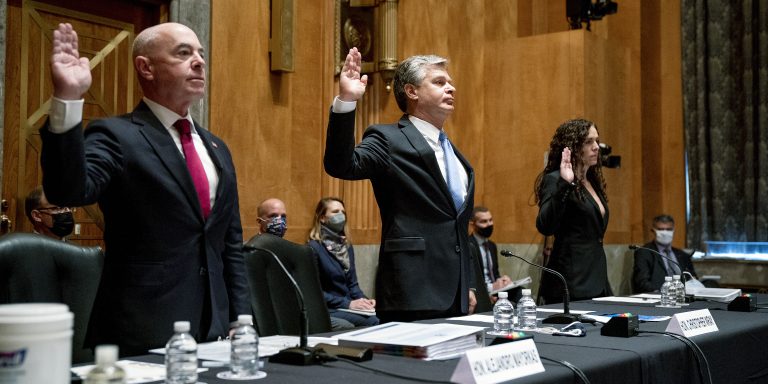INTELBRIEF
September 23, 2021
IntelBrief: An Overview of Current National Security Threats to the United States

Bottom Line Up Front
- On Tuesday, the Senate Homeland Security Committee heard testimony from some of the United States’ top national security officials, as they outlined the threat posed by everything from terrorism to cyberespionage.
- The FBI has more than doubled its domestic terrorism investigations in the past eighteen months and increased personnel dedicated to dealing with domestic terrorism by an astonishing 260%.
- The domestic terrorism threat is more diverse than ever, with homegrown violent extremists and a range of domestic violent extremists occupying the bandwidth of local, state, and federal officials.
- FBI Director Christopher Wray noted that recent events in Afghanistan could inspire acts of terrorism and violent extremism in the United States.
On Tuesday, the Senate Homeland Security Committee heard testimony from some of the United States’ top national security officials during its annual hearing on threats to the country. International terrorism and domestic terrorism remain leading threats, while cybercrime and ransomware attacks, especially those emanating from China and Russia, are also major concerns. There is a significant counterintelligence threat posed by China, which engages in economic espionage and intellectual property theft, pilfering proprietary data from universities, research laboratories, and private sector corporations. In fact, the threat posed by China is so persistent, that the Federal Bureau of Investigation (FBI) opens a new probe into cases involving China every twelve hours. Hackers from China, Russia, and Iran have previously engaged in operations to steal vaccine related data from pharmaceutical companies, healthcare firms, and research centers.
In the past eighteen months, the FBI has increased personnel dedicated to dealing with domestic terrorism by an astonishing 260%. Ongoing investigations into domestic terrorism more than doubled during this time frame, increasing from approximately 1,000 to 2,700 cases. The FBI has thwarted potential terrorist attacks in Cleveland, Kansas City, Las Vegas, Miami, New York, Pittsburgh, and Tampa over the past several years. There has also been a surge in attacks and attempted attacks against law enforcement officers, with 52 felonious deaths reported in the first eight months of 2021, compared to 46 in the whole of 2020. There is concern that the Capitol insurrection of January 6, 2021, could serve to inspire domestic terrorists, including conspiracy theorists, militia groups, and an assortment of anti-government and anti-authority extremists. The ongoing COVID-19 pandemic and protests against mask mandates and vaccines are likely to further exacerbate existing tensions, offering more opportunities for domestic violent extremists to spread propaganda and recruit new members.
Director of the National Counterterrorism Center (NCTC) Christine Abizaid testified that the likelihood of major attacks on American soil is “less acute” than in years past, but cautioned that deterring attacks remains a challenge, as the threat is also more diverse than ever, with homegrown violent extremists and a range of domestic violent extremists occupying the bandwidth of local, state, and federal officials. Involuntary celibates, or “Incels,” neo-Nazis, white supremacists, QAnon adherents, and individuals inspired by Salafi-jihadists continue to pose threats of violence, as do so-called “salad bar” terrorists motivated by concepts like accelerationism. Terrorists could also be aided by greater access to emerging technologies, including drones, 3-D printing, and artificial intelligence. After two decades of focusing intensely on terrorism and counterterrorism, the United States is now altering its posture to deal with great power competition and the threat posed by longstanding rivals like Russia, China, Iran, and North Korea. There are growing concerns within the U.S. national security establishment that resources are being spread too thin, and that critical manpower will be diverted from counterterrorism at a time when Washington is still trying to adapt to a new threat landscape as it takes shape.
Secretary of the Department of Homeland Security (DHS) Alejandro Mayorkas noted that social media has complicated the jobs of both DHS and other agencies in the U.S. government, given the ability of extremists and their supporters to radicalize others, spread mis- and disinformation, and communicate with each other. FBI Director Christopher Wray concurred, noting that “terrorism moves at the speed of social media.” Director Wray also cautioned that recent events in Afghanistan could inspire extremism in the United States. If a Taliban-led Afghanistan allows groups like al-Qaeda to regenerate, there exists the possibility of an accompanying surge in jihadist propaganda, including propaganda that deliberately calls on Muslims in Western countries to conduct terrorist attacks. There is also a concern that Islamic State Khorasan (ISK) could rebuild its external operations planning capabilities and, with more resources and manpower, eventually look to target the West with terrorist attacks. NCTC Director Abizaid said, “I think it is fair to assess that the development of those groups’ external operations capability, we’ve got to monitor and assess whether that’s going to happen faster than we had predicted otherwise,” going on to conclude that “Afghanistan is a very dynamic environment right now.”